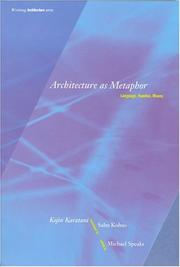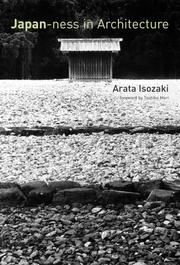| Listing 1 - 5 of 5 |
Sort by
|
Book
ISBN: 9780262612074 Year: 2005 Publisher: Cambridge, Mass. : copyright 2003 MIT,
Abstract | Keywords | Export | Availability | Bookmark
 Loading...
Loading...Choose an application
- Reference Manager
- EndNote
- RefWorks (Direct export to RefWorks)
Political science --- Economics --- Philosophy. --- Kant, Immanuel, --- Marx, Karl,

ISBN: 0262611139 9780262611138 Year: 1995 Publisher: Cambridge (Mass.) : MIT press,
Abstract | Keywords | Export | Availability | Bookmark
 Loading...
Loading...Choose an application
- Reference Manager
- EndNote
- RefWorks (Direct export to RefWorks)
In Architecture as Metaphor, Kojin Karatani detects a recurrent "will to architecture" that he argues is the foundation of all Western thinking, traversing architecture, philosophy, literature, linguistics, city planning, anthropology, political economics, psychoanalysis, and mathematics. Kojin Karatani, Japan's leading literary critic, is perhaps best known for his imaginative readings of Shakespeare, Soseki, Marx, Wittgenstein, and most recently Kant. His works, of which Origins of Modern Japanese Literature is the only one previously translated into English, are the generic equivalent to what in America is called "theory." Karatani's writings are important not only for the insights they offer on the various topics under discussion, but also as an example of a distinctly non-Western critical intervention. In Architecture as Metaphor, Karatani detects a recurrent "will to architecture" that he argues is the foundation of all Western thinking, traversing architecture, philosophy, literature, linguistics, city planning, anthropology, political economics, psychoanalysis, and mathematics. In the three parts of the book, he analyzes the complex bonds between construction and deconstruction, thereby pointing to an alternative model of "secular criticism," but in the domain of philosophy rather than literary or cultural criticism. As Karatani claims in his introduction, because the will to architecture is practically nonoexistent in Japan, he must first assume a dual role: one that affirms the architectonic (by scrutinizing the suppressed function of form) and one that pushes formalism to its collapse (by invoking Kurt Godel's incompleteness theorem). His subsequent discussions trace a path through the work of Christopher Alexander, Jane Jacobs, Gilles Deleuze, and others. Finally, amidst the drive that motivates all formalization, he confronts an unbridgeable gap, an uncontrollable event encountered in the exchange with the other; thus his speculation turns toward global capital movement. While in the present volume he mainly analyzes familiar Western texts, it is precisely for this reason that his voice discloses a distance that will add a new dimension to our English-language discourse.
1 --- 13 --- Filosofie --- Cultuurfilosofie --- Architecture and philosophy --- Cross-cultural studies --- Structural analysis (Engineering) --- Architecture --- Philosophy --- Architecture - Philosophy

ISBN: 9780262090384 0262090384 9780262516051 0262516055 Year: 2011 Publisher: Cambridge, Mass ; London : MIT,
Abstract | Keywords | Export | Availability | Bookmark
 Loading...
Loading...Choose an application
- Reference Manager
- EndNote
- RefWorks (Direct export to RefWorks)
Japanese architect Arata Isozaki sees buildings not as dead objects but as events that encompass the social and historical context—not to be defined forever by their "everlasting materiality" but as texts to be interpreted and reread continually. In Japan-ness in Architecture, he identifies what is essentially Japanese in architecture from the seventh to the twentieth century. In the opening essay, Isozaki analyzes the struggles of modern Japanese architects, including himself, to create something uniquely Japanese out of modernity. He then circles back in history to find what he calls Japan-ness in the seventh-century Ise shrine, reconstruction of the twelfth-century Todai-ji Temple, and the seventeenth-century Katsura Imperial Villa. He finds the periodic ritual relocation of Ise's precincts a counter to the West's concept of architectural permanence, and the repetition of the ritual an alternative to modernity's anxious quest for origins. He traces the "constructive power" of the Todai-ji Temple to the vision of the director of its reconstruction, the monk Chogen, whose imaginative power he sees as corresponding to the revolutionary turmoil of the times. The Katsura Imperial Villa, with its chimerical spaces, achieved its own Japan-ness as it reinvented the traditional shoin style.And yet, writes Isozaki, what others consider to be the Japanese aesthetic is often the opposite of that essential Japan-ness born in moments of historic self-definition; the purified stylization—what Isozaki calls "Japanesquization"—lacks the energy of cultural transformation and reflects an island retrenchment in response to the pressure of other cultures.Combining historical survey, critical analysis, theoretical reflection, and autobiographical account, these essays, written over a period of twenty years, demonstrate Isozaki's standing as one of the world's leading architects and preeminent architectural thinkers.
Architecture --- 72 --- 72.03 --- Japan --- 72.032.12 --- Isozaki, Arata --- Architecture, Japanese --- Philosophy. --- Architectuur --- Architectuur (geschiedenis) --- Architectuurgeschiedenis --- Japanse architectuur --- Architecture. --- Architektur --- Philosophie --- Architektur. --- Philosophie. --- Arkitektur. --- Chōsen Kōgei Kenkyūkai --- Japan. --- Philosophy --- Isozaki, Arata. --- 72.07 --- 72.01 --- 72(520) --- Arata Isozaki °1931 (°Oita City, Japan) --- Architectuur ; 2de h. 20ste eeuw ; A. Isozaki --- Metabolisme --- Architecten. Stedenbouwkundigen A - Z --- Architectuur ; theorie, filosofie, esthetica --- Architectuur ; Japan --- J6500 --- Japan: Art and antiquities -- architecture
Book

ISBN: 9782955573839 2955573833 Year: 2018 Publisher: Vaulx-en-Velin : Editions des Mondes à faire,
Abstract | Keywords | Export | Availability | Bookmark
 Loading...
Loading...Choose an application
- Reference Manager
- EndNote
- RefWorks (Direct export to RefWorks)
La couverture indique : "Le 11 mars 2011 un tsunami ravage la côte nord-est du Japon. Les jours suivants, trois réacteurs explosent dans la centrale nucléaire de Fukushima-Daiichi. À cette catastrophe s’en est ajoutée une autre : la gestion gouvernementale du désastre. Loin d’être un « accident » désormais « sous contrôle », le drame se poursuit par mille conséquences plus ou moins visibles : pollution, déplacements de populations, bouleversement des intimités. À travers le récit de six activistes japonais, ce livre tente de penser autrement le désastre nucléaire. Un phénomène qui remet en cause la texture même de la matière doit, aussi, être abordé comme une catastrophe métaphysique."
Book

ISBN: 9783433026335 3433026335 Year: 1991 Publisher: Berlin : Ernst & Sohn,
Abstract | Keywords | Export | Availability | Bookmark
 Loading...
Loading...Choose an application
- Reference Manager
- EndNote
- RefWorks (Direct export to RefWorks)
Deconstructivism (Architecture) --- Architecture --- Déconstructivisme (Architecture) --- Exhibitions --- History --- Expositions --- Histoire --- Eisenman Architects --- Exhibitions. --- Rebstockpark (Frankfurt am Main, Germany) --- Déconstructivisme (Architecture)
| Listing 1 - 5 of 5 |
Sort by
|

 Search
Search Feedback
Feedback About UniCat
About UniCat  Help
Help News
News